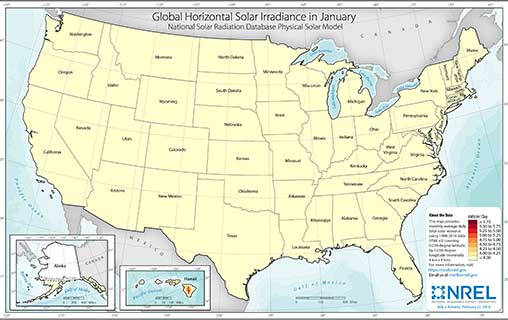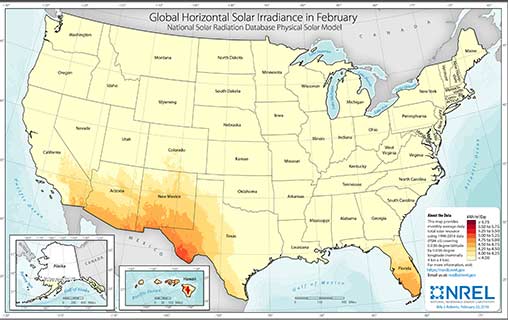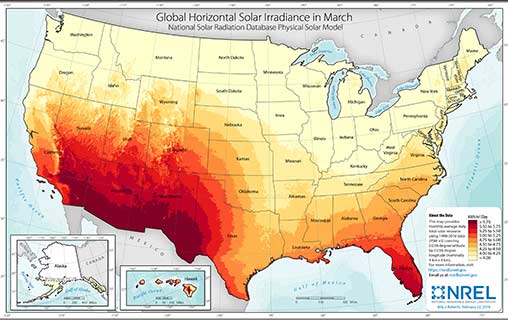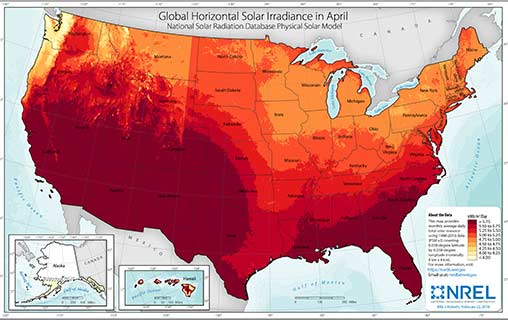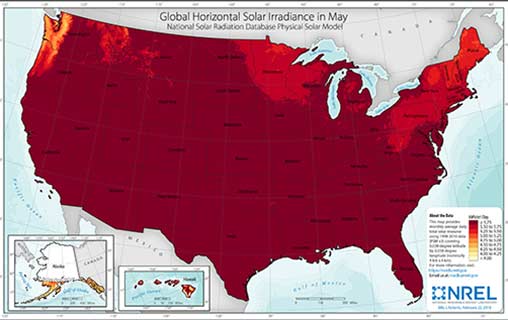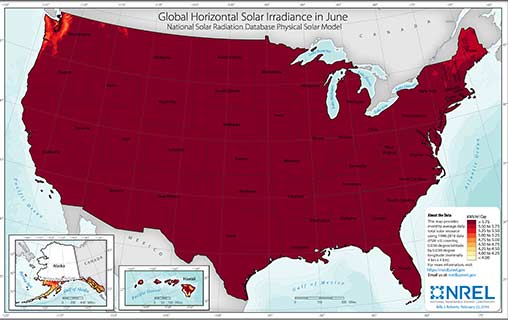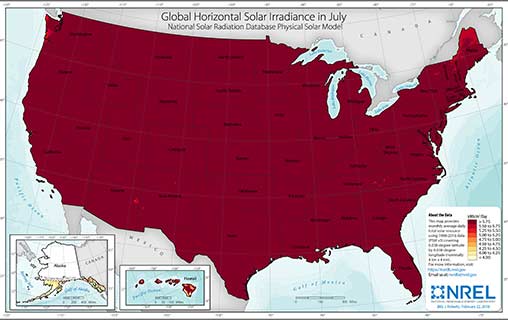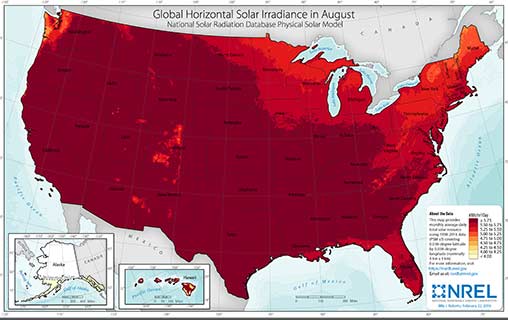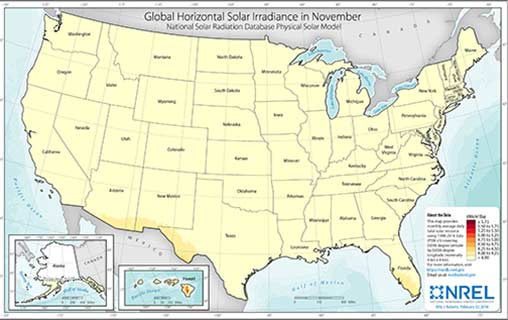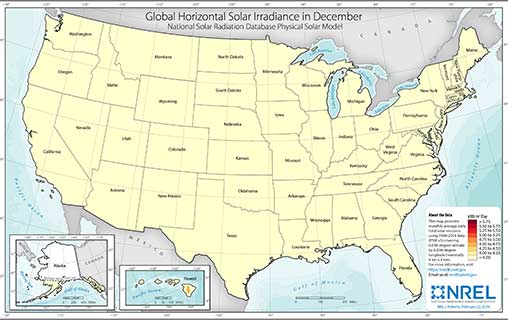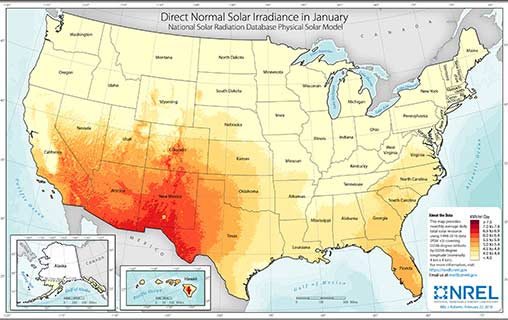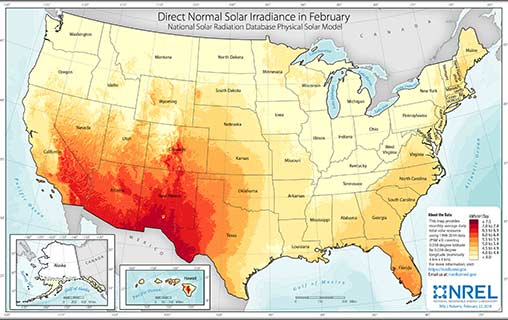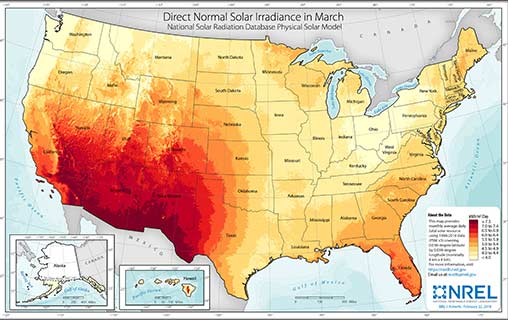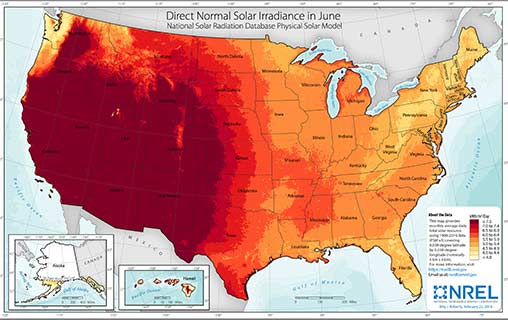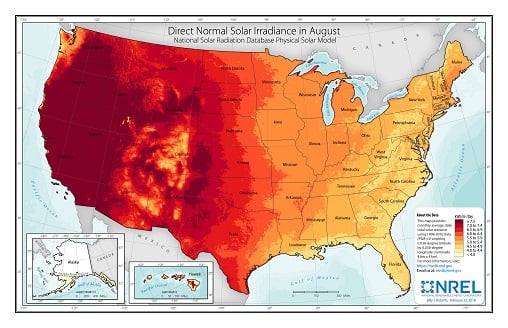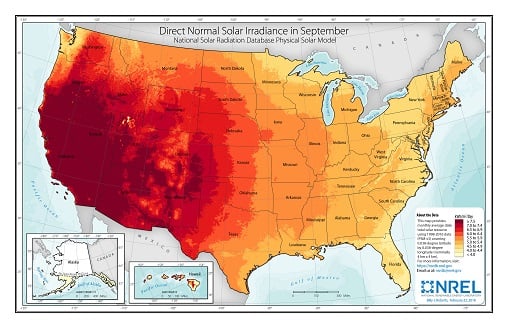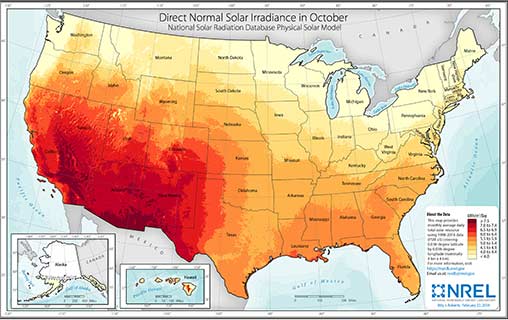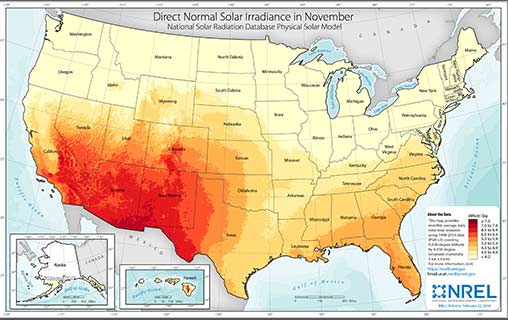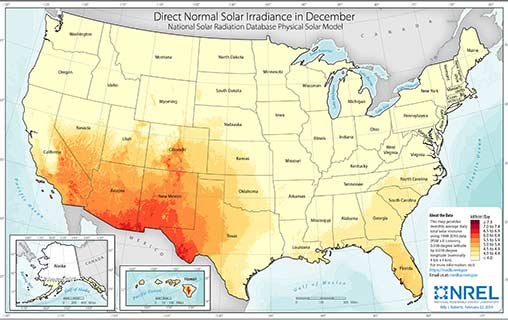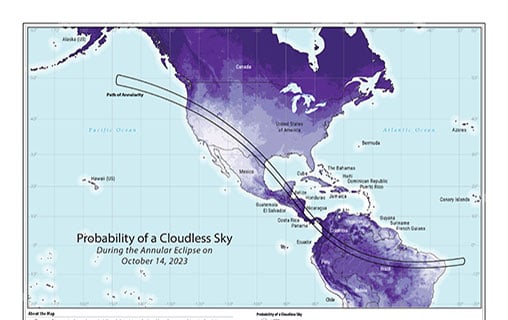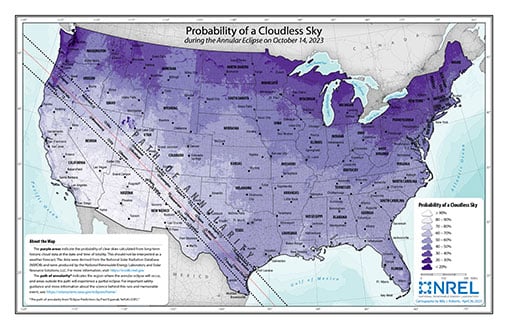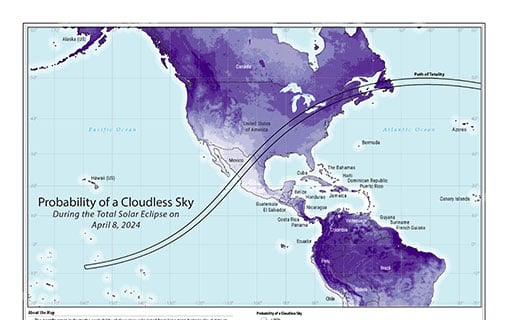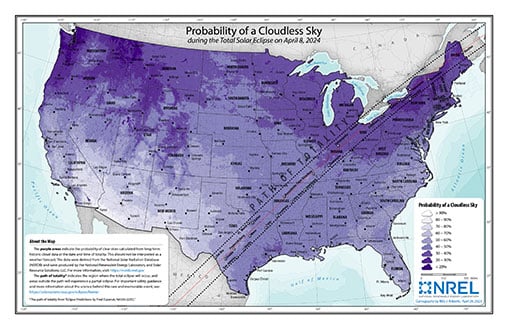Solar Resource Maps and Data
Find and download solar resource map images and geospatial data for the United States and the Americas.
For more information on NLR's solar resource data development, see the National Solar Radiation Database (NSRDB).
Maps
The maps below illustrate select multiyear annual and monthly average maps and geospatial data from the National Solar Radiation Database (NSRDB) Physical Solar Model (PSM). The PSM covers most of the Americas. Learn about the NSRDB PSM.
To access the data directly and learn more about data development, please visit the NSRDB.
These maps may be used in electronic and printed publications with proper citation.
Global Horizontal Irradiance
Download the global horizontal irradiance (GHI) maps individually below, or download all the GHI maps at once.
Note: The publication dates listed below don't necessarily reflect the publication dates of the data therein.
Annual Average
Model: PSM v3.0
Publication Date: Feb. 22, 2018
File Type/Resolution: JPG, 300 ppi
Global Horizontal Solar Irradiance—Americas (Print Format: 8.5”x11”)
This map provides annual average total daily solar resource from PSM v3 at a resolution of 0.038-degree latitude by 0.038 longitude (nominally 4 km x 4 km). The insolation values represent the resource available for solar energy systems. These values were created using the adapted PATMOS-X model for cloud identification and properties, which are then used as inputes to the REST2 model for clear sky and NLR’s FARMS model for cloudy sky radiation calculations. REST2 calculates both DNI and GHI. FARMS calculates GHI, and the DISC model is then used to calculate DNI. The map is generated using the 1998-2016 dataset. Aerosol optical properties are derived from MODIS and MISR satellite products while atmospheric parameters are obtained from NASA’s MERRA product. For more information, please visit NSRDB or email NSRDB.
This map provides annual average daily total solar resource using 1998-2016 data (PSM v3) covering 0.038-degree latitude by 0.038-degree longitude (nominally 4 km x 4 km). For more information, please visit NSRDB or email NSRDB.
Monthly Averages
The monthly average maps use the same color scale and class breaks as the annual average map for the contiguous United States for the purpose of showing monthly variation relative to the annual average. These maps provide monthly average daily total solar resource using 1998-2016 data (PSM v3) covering 0.038-degree latitude by 0.038-degree longitude (nominally 4 km x 4 km). For more information, please visit NSRDB or email NSRDB.
Model: PSM v3.0
Publication Date: Feb. 22, 2018
File Type/Resolution: JPG, 300 ppi
Print Format: Tabloid (11”x17”)
Direct Normal Irradiance
Download the direct normal irradiance (DNI) maps individually below, or download all the DNI maps at once.
Note: The publication dates listed below don't necessarily reflect the publication dates of the data therein.
Annual Average
Model: PSM v3.0
Publication Date: Feb. 22, 2018
File Type/Resolution: JPG, 300 ppi
Direct Normal Solar Irradiance—Americas (Print Format: 8.5”x11”)
This map provides annual average total daily solar resource from PSM v3 at a resolution of 0.038-degree latitude by 0.038 longitude (nominally 4 km x 4 km). The insolation values represent the resource available for solar energy systems. These values were created using the adapted PATMOS-X model for cloud identification and properties, which are then used as inputs to the REST2 model for clear sky and NLR’s FARMS model for cloudy sky radiation calculations. REST2 calculates both DNI and GHI. FARMS calculates GHI, and the DISC model is then used to calculate DNI. The map is generated using the 1998-2016 dataset. Aerosol optical properties are derived from MODIS and MISR satellite products while atmospheric parameters are obtained from NASA’s MERRA product. For more information, please visit NSRDB or email NSRDB.
U.S. Annual Solar DNI (Print Format: 11”x17”
This map provides annual average daily total solar resource using 1998-2016 data (PSM v3) covering 0.038-degree latitude by 0.038-degree longitude (nominally 4 km x 4 km). For more information, please visit NSRDB or email NSRDB.
Monthly Averages
The monthly average maps use the same color scale and class breaks as the annual average map for the contiguous United States for the purpose of showing monthly variation relative to the annual average. These maps provide monthly average daily total solar resource using 1998-2016 data (PSM v3) covering 0.038-degree latitude by 0.038-degree longitude (nominally 4 km x 4 km). For more information, please visit NSRDB or email NSRDB.
Model: PSM v3.0
Publication Date: Feb. 22, 2018
File Type/Resolution: JPG, 300 ppi
Print Format: Tabloid (11”x17”)
Eclipse Maps
Annular Eclipse Oct. 14, 2023
The purple areas indicate the probability of clear skies calculated from long-term historic cloud data at the date and time of totality. This should not be interpreted as a weather forecast. The data were derived from the National Solar Radiation Database (NSRDB) and were produced by the National Laboratory of the Rockies and Solar Resource Solutions, LLC. For more information visit NSRDB. The path of annularity (from “Eclipse Predictions by Fred Espenak, NASA’s GSFC”) indicates the region where the annular eclipse will occur, and areas outside the path will experience a partial eclipse. For important safety guidance and more information about the science behind this rare and memorable event, visit NASA Eclipse.
Solar Eclipse April 8, 2024
The purple areas indicate the probability of clear skies calculated from long-term historic cloud data at the date and time of totality. This should not be interpreted as a weather forecast. The data were derived from the National Solar Radiation Database (NSRDB) and were produced by the National Laboratory of the Rockies and Solar Resource Solutions, LLC. For more information visit NSRDB. The path of totality (from “Eclipse Predictions by Fred Espenak, NASA’s GSFC”) indicates the region where the total eclipse will occur, and areas outside the path will experience a partial eclipse. For important safety guidance and more information about the science behind this rare and memorable event, visit NASA Eclipse.
Geospatial Data
To make the above maps, the multiyear solar irradiance was calculated from the NSRDB. These derived data sets are provided below as geospatial rasters.
To view and use these data sets, you need appropriate geographic information system software.
The Americas
Cite the Maps and Data
Please cite use of the maps and data accordingly.
Sengupta, M., Y. Xie, A. Lopez, A. Habte, G. Maclaurin, and J. Shelby. 2018. "The National Solar Radiation Data Base (NSRDB)." Renewable and Sustainable Energy Reviews 89 (June): 51-60.
Contact
If you have any questions about the maps and data, please contact us.
Share
Last Updated Dec. 6, 2025



